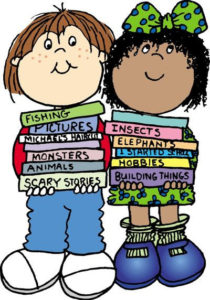The Three I’s

Interest:
Interest-motivated reading is when a child seeks out reading materials for information and/or enjoyment. It is the motivation for pleasure reading. Maybe it’s enjoying a book after seeing a related movie, wanting to read material that a parent or teacher has shared, taking a book to camp or on vacation, reading on a rainy day, or pursuing a particular interest. Anything we do for pleasure can have visceral or emotional effects: smiles, laughter, tears; the feeling of being less alone; the sense that time is flying; the thrill of new ideas and dreams. Anything we do for pleasure is also likely something we will want to repeat in the future, so even though interest is the simplest motivation, it is also the crux. Ideally it is joyful reading, indicative of will and individual taste. It is a lucky child who is allowed to choose his own books without judgment and whose parents and teachers suggest books solely to
make the day more pleasant. It is through the freedom of choice that the child become self-actualized as a reader and is more likely to read for a lifetime.
Sample role-playing of a parent supporting a child towards interest motivated reading:
- “You can stay up as late as you want tonight, as long as you’re reading.”
- “I know you like baseball. Here’s a book of Hall-of-Famers.”
- “Here is a flashlight. I’ve set a place for you in the closet/under the table/on those pillows over there, so you can have a private spot to read.”
- “I’ve been saving this present for a rainy day. Here’s a new book/my favorite book from when I was your age.”
- “It’s hard to wait! Here, read this, it’ll make the time fly by.”
- “Would you keep me company while I sort laundry by reading me an article that interests you from the newspaper?”
- “Tell me about that book you just finished. It looked interesting.”
Integration:
Integration happens when a child is convinced to use reading as a springboard into other disciplines. The end product is often more tangible than interest-motivated reading, but still is directly related to the reading of a book. Integration takes books into the real world, where life (unlike most classroom studies) is not separated into subject areas, and where things are made and done. Your child may read a nonfiction book because of interest in the subject, but the outcome (knowing how to play a sport, measuring ingredients for a recipe, wowing friends with a yo-yo skill) may result in experiences that reach far beyond the pleasures and boundaries of the printed page.
Sample role-playing of a parent guiding a child to an integrated reading experience:
- “Why do you think that illustrator chose to put this character alone on the page, with all this space around him? Does the character seem near or far from us? How did the illustrator make it seem that way?” (Reading = art)
- “I’m so glad you enjoyed Joanna Cole’s Ms. Frizzle’s Adventures in Ancient Egypt. Let’s go to the Field Museum this weekend and find out the real story about ancient Egypt.” (Reading = history, social studies.)
- “I can’t get this lawnmower/clock/toy to work. Would you mind going to the library to see if you can find The Way Things Work by David McCauley to show us how it operates, so we can fix it?” (Reading = science.)
Invention:
Invention-motivated reading does not only reflect the many facets of the book, it showcases the many facets of the reader. The best way to tell when invention-motivated reading has occurred is when the child produces something that integrates disciplines, but is unlikely or impossible to be duplicated by another child. The child departs from a formula, allowing the writing to influence his own ideas, but not dictate the final product. Reading that motivates initiative may be the most powerful of all. Such reading helps children experiment—and ultimately decide—what kind of people they want to be. Such reading helps children invent themselves. Invention-motivated children aren’t just reading books. They are doing books, living books. As far as the
family goes, this kind of reading can result in treasured memories and mementos.
Sample role-playing of a parent supporting a child towards convention–motivated reading:
- “Wouldn’t it be fun to put together a little performance based on one of our books for a little after-dinner entertainment?”
- “Oh, what a long road trip ahead of us! What about taking this tape recorder and reading aloud a book, maybe make it into a kind of radio show that we can all listen to while we travel?”
- “Here’s a pioneer lunch of johnnycake and venison (corn bread and cold steak sandwich) to eat while you are living in The Little House in the Big Woods (in the backyard). Beware of bears!”
- “I love your collage! It looks like you got a lot of ideas from Ezra Jack Keats’s The Snowy Day.”
- “Wow! The paper airplane you designed flies as well as the plane you read about in Alice and Martin Provensen’s The Glorious Flight.”
Helping children to read more is the first step to success, so one motivation is not more valid than another. In combination, they are building blocks to a lifelong love of reading and learning and a sense of competency that may translate into higher test scores and better success with other challenges. In combination, they create a fourth “I,” Identity: I am a reader. I am a lover of books. I can get the information I need from words. I have the power of literacy.
(Handout content taken from How to Get Your Child to Love Reading by Esmé Raji Codell)